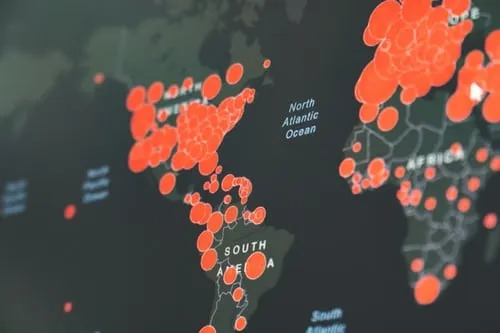How To Survive as an Exhibitor during the Covid-19 Pandemic
We’ve all heard it: “Avoid congregating in groups of 10 or more for the next 7-8 weeks.”
What are the implications for the medical industry — typically in the throes of spring conference season? It means change – sometimes last-minute.
According to a poll from Eventsforce earlier this month, 49% of event planners have said the virus has already had an impact on their events1. UFI (The Global Association of Exhibition Industry) reports that more than 500 trade shows have not taken place in recent weeks, costing up to $26 billion in lost orders for exhibitors globally2.

But there are concrete things you can do to make sure you and your company still achieve event strategy goals. This white paper will help you adapt to these new circumstances that sometimes feel out of control.
First: Take a deep breath!
With so many trade show cancellations and postponements, it is only natural to be frustrated and anxious about what the future holds. Take a deep breath. You are not in this alone!
Take this time to speak with key stakeholders, HR, and other event and marketing professionals to develop a tradeshow and events operating plan that more closely aligns with this new “bare bones” event world we find ourselves in. The more that you can act instead of REact, the better!
Second: Get clarification.
You got the news: another change in an upcoming tradeshow. Now’s the time to get clarification: Is it a postponement or a cancellation?
- If it’s a postponement, here’s what you need to act on NOW:
- Confirm the new dates, and start planning — The new dates will likely come during a time you: (A) Typically aren’t planning a major event (i.e., August, when most of the industry avoids events that conflict with family vacations), or (B) Are already juggling other events.
- Get the staff! — Communicate updated dates, location, and logistics as soon as possible to your colleagues, so you and your team aren’t scrambling to find coverage at the last minute.
- Get the stuff! — We all know coordinating shipment of booth collateral and literature is no small feat. Either you, or someone on your events team, needs to reach out to your literature fulfillment center and exhibit house as soon as possible. Make sure you have ample collateral and literature to cover your events in a time that would typically be your slow period but will now be booming.
- If it’s a cancellation — and this event won’t be held again until next year, you likely will prefer to get a refund NOW, rather than applying your credit toward next year’s fees (for accounting purposes).
- Get the facts — You can typically find information about cancellations and refunds on the event website under FAQs.
- Review cancellation policies — If you’ve booked rooms, venues, and airfare, check with your vendors on their latest policies (specifically force majeure), as many are offering some leniency on cancellations without penalties.
- Communicate, communicate, communicate — Along with speaking to vendors, update your associates. Give them the full picture as to what this cancellation impacts – budget, planned activities, missed opportunities for voice of customer, sales dinners, abstracts, podium presence, etc

Third: Plan alternatives.
So, now what? This conference was likely the forum for you to communicate a new product, expanded indications, new clinical data or other important information. How else can you reach your target audience in the interim until another industry-specific event happens in the fall?
- Talk to your industry relationship liaisons — Is the association or medical society suggesting alternatives, such as virtual events or distance learning? If so, explore those and consider engaging in them. Obviously, you won’t be able to have an exhibit presence exactly like you would at an in-person event, but there are other options: Can you be listed as a sponsor on the virtual slide deck? Have your logo or ad splashed on-screen during breaks? Contribute virtual meeting content via staff experts or industry KOLs?
- Determine existing forums —Is there another industry-recognized digital forum that offers clinical education you can leverage? Lots of organizations are setting up webinars and virtual conferences. You are better served to jump on an existing platform that is consolidating and streamlining these programs, rather than competing with your own.
- Example – EndoscopyNow is a free digital app for the gastroenterology/endoscopy global community and posts videos from industry events.
- Do it yourself —As a last resort, if you consider hosting your own webinar, remember:
- Planning for a virtual event is just as involved as an in-person event.
- You’ll likely face stiff competition and will need to stand out from the crowd, in order to ensure good attendance.
Fourth: Now, get ahead of it!
In addition to handling changes on a case-by-case basis, here are things you can do PROACTIVELY to prepare for the months ahead:
- Do some sleuthing — Look at all upcoming tradeshows in the first half of this year and put on your detective hat. Many tradeshow planners and associations are closely monitoring COVID-19 and making determinations, sometimes months in advance, to postpone or cancel.

If you can’t find information online, reach out to tradeshow planners on an individual basis, and ask for an update on the show’s status.
- Crunch the numbers — Update your budget to reflect a heavy second half of the year and see where you can adjust in the first half to prepare.
- Pick brains — Along with attending this webinar, talk to leaders in your field, partner with your training and education team, and do online research. Some online resources to check out: LinkedIn, HCEA, Eventsforce, PCMA, MPI, and Association of Event Organizers.
- Spread the knowledge — Create a regularly scheduled COVID-19-related communication to send to your internal and external key stakeholders to keep them abreast of the current tradeshow landscape.
- Become virtually savvy — Research different virtual programs, platforms, and opportunities to determine what works best for you and your target audience. Also, keep in mind that production companies are shifting their focus from meeting production to virtual meeting logistics and management, and could be great partners and resources.
- Weigh your options — Review your 2020 marketing strategy and product launch timeline. Determine what alternative or new virtual mediums you have in Q1 and Q2 to reach customers and what opportunities you anticipate in Q3 and Q4 for in-person/conference marketing and promotional activities.
- Look at things with a fresh perspective — Now that you have a moment, take time to review your company’s current booth collateral. Do you need to update your exhibit branding? Does branding reflect your latest marketing strategy? How can you make a splash at the next tradeshow?
This, too, shall pass. Until it does, though, we hope you can take the information you learned here and apply it. Please also share your best practices with the event community, as well.
Sources
- 1 “What Event Planners Need to Know About Coronavirus.” Eventsforce, 19 Mar. 2020, eventsforce.com/us/blog/what-event-planners-need-to-know-about-covid-19/.
- 2 Campos, Guy. “’Five Hundred Trade Shows Cancelled, Costing $26bn’.” AV Magazine, 16 Mar. 2020, www.avinteractive.com/news/business/ufi-releases-first-global-assessment-of-the-economic-impact-that-covid-19-is-having-on-trade-shows-and-exhibitions-12-03-2020/